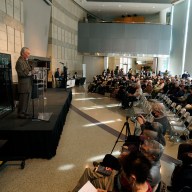The Royal Ontario Museum now houses an ancient military that unified a civilization.
The Warrior Emperor and China’s Terracotta Army reveals the findings from the 2,200-year-old tomb of the first Chinese emperor. The burial chamber contained 8,000 life sized fighter sculptures, which were only part of a huge effort to provide the deceased king with everything he would need in the afterlife.
“This exhibit explores China after 500 years of war,” explained senior ROM curator Dr. Chen Shen, at Friday’s opening ceremonies in the museum’s foyer. “Archeologists in Shaanxi province found more than a mausoleum; they found a complete recreation of that time and place.”
The exhibition includes sculptures from the 1974 discovery, including archers and two of the nine life size generals from China’s Qin Dynasty. Each terracotta statue has a distinct face. For military enthusiasts, there are real swords and suits of armour. A crossbow with its original reddish varnish is on display, along with videos with actors explaining how China’s Emperor Zheng unified a bunch of squabbling fiefdoms.
According to Shen, the scale of the tomb goes beyond kingly grandeur. “The emperor was as much of a revolutionary in death as he was in life,” said Shen, “through commissioning the reproduction of his entire world through art.”
Among the 244 pieces imported for this exhibition are also the things an army in the afterlife needs, including cooking pots and building materials and even entertainers. The overall effect is less about learning about Emperor Zheng than it is about immersing one’s self in daily life in Ancient China.
The completeness of the exhibition is what’s most striking about it; life sized terracotta horse sculptures are of course amazing, and they make the real ancient Chinese riding bridles and other equestrian gear more fascinating.
Ordinary things like pipes and building materials make the exhibition as intimate as it is grand. It reveals through relics and video how the next few centuries of a recently united China played out. All the ancient goods here are entertainingly contextualized.
Shen sees this discovery as a victory for science and for humanity, containing one of the most poignant ironies in archeological history.
“The emperor planned to live forever in the afterlife, and mortal eyes were not supposed to ever see his terracotta army,” said Shen, “but it was not until his tomb was discovered that mortals made him immortal.”
• Buy tickets for The Warrior Emperior and China’s Terracotta Army at www.rom.on.ca/terracottaarmy. The exhibit is on until January 2, 2011.
















